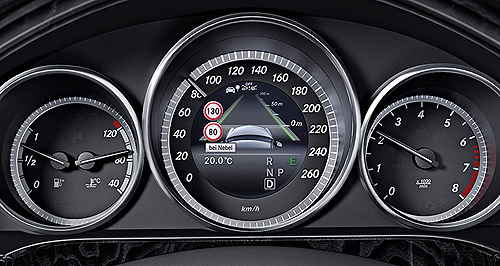News - Mercedes-BenzBenz speed recognition tech tripped in AusSign of the times: Benz’s new speed sign recognition system will not be included on the updated S-Class. Local speed signs force Benz to reconfigure active safety tech in Australia30 Mar 2017 MERCEDES-BENZ Australia/Pacific has revealed that it will not introduce the speed limit recognition system that can sync with adaptive cruise control available globally on the S-Class from later this year, following issues with Australian signage detection. Speaking with GoAuto at the national media launch of the Mercedes-AMG E43 in Melbourne last week, Mercedes-Benz manager of validation and communication for active safety and assistance systems, Jochen Haab, revealed that Australia’s time-based school zones and flashing variable speed signs have tripped up its speed limit recognition system, and will be omitted from local vehicles. The system, dubbed Active Speed Limit Assist, uses navigation data linked with stereo cameras detecting speed signs to automatically set the cruise control system, which is set to debut globally in the facelifted Mercedes-Benz S-Class due for public reveal at next month’s New York motor show. “The biggest thing that will not be there for (Australian S-Class) market launch will be the speed limit assist,” Mr Haab explained, adding that current systems that only display the speed limit in the information display did not have the same consequences of a false speed limit reading compared with the active cruise control adaption system being introduced. “The basis of a speed adaption system is a speed recognition system, now a speed recognition is a system that displays the recognised speed in your instrument or head-up display, and if you have that display you are still responsible for adjusting your speed, it’s an information system. “The tolerances you have there, because you still have the responsibility of driving as fast as you should, is still with you, so the tolerance of a ‘false positive’ or ‘falsely detected signage’ is not so dramatic. “When you take the next step, which we do on a global scale in many countries (with S-Class) and (adaptive cruise control) automatically adapts to that speed, then of course it becomes a whole different story, because the car will react.” He advised that the flashing red ring of a variable speed limit sign on the freeway, or to denote that a school zone is active, have not been part of the Active Speed Limit Assist development program as such signage is not found in many countries around the world. The flashing part of the equation, he said, could result in a failed detection of the sign or a false reading of the sign. “Imagine driving on the motorway and you had one of those flashing LED signs,” he continued. “You could have say 100km/h and it goes down to 40km/h because of road construction. If it didn’t pick it up you would be speeding with 100km/h, which is dangerous. It could get expensive or even nastier than that. We don’t have that (in Germany).” Even without the flashing issue of a school zone, however, the system is unable to read at which times the school zones are enforced, which could regulate the vehicle to drive at a lower speed when it is not required to do so. “We cannot ‘read’ but we can only compare standards through a database,” he said. “Reading skills of cars will improve, you all know how fast picture detection systems (have evolved) these days, but we have to get close to 100 per cent. A 70 per cent solution would not be very good realistically on the road (particularly) if you pass that same sign every day.” While the Mercedes-Benz system will automatically adapt to the speed limit sign, the driver can also override the system by pressing the throttle in under two seconds of a speed limit change. Rival BMW has introduced speed limit adaption software on its 5 Series and 7 Series models, but conversely the system first asks whether the driver wants to adapt the active cruise control to the recognised speed sign. Mr Haab believed that this was not an adequate solution for Mercedes-Benz, however. “That could be one (solution) and we did look at that in development, but we weren’t happy with it,” he said of the BMW system. “We as engineers weren’t happy with it and (in) field validation even in most countries … our research shows people weren’t happy with that. Sometimes it was too much information for them, with every speed sign: ‘Do you want to accept yes/no?’ it distracts as well. “From the research we did in field validation we will not do that. We feel that if we show (the speed) it should be as good as possible, and what we experienced here led us to the decision to say no, we’ll code it out for Australia. We don’t want people to have false information.” Mr Haab revealed that part of the reason for the announcement that Mercedes-Benz would use an E-Class prototype in Australia was for research into next-generation active safety systems including finding solutions to recognise our particular signage. “One of the goals of this car (E-Class prototype) is … we are looking into the problems we’re running into,” he added. “School zones, flashing LED signs, (we will test) then we’ll draw our conclusions. If I knew the solution I wouldn’t have to test. On a short-term timeline we could come up with a solution that we feel is Mercedes-like. “It (the BMW system) could be a solution for Australia, but a better way would be to look for those ‘dirty spots’ and clean them out. That’s the better way to go.”  Read more |
Click to shareMercedes-Benz articlesResearch Mercedes-Benz Motor industry news |

















Facebook Twitter Instagram